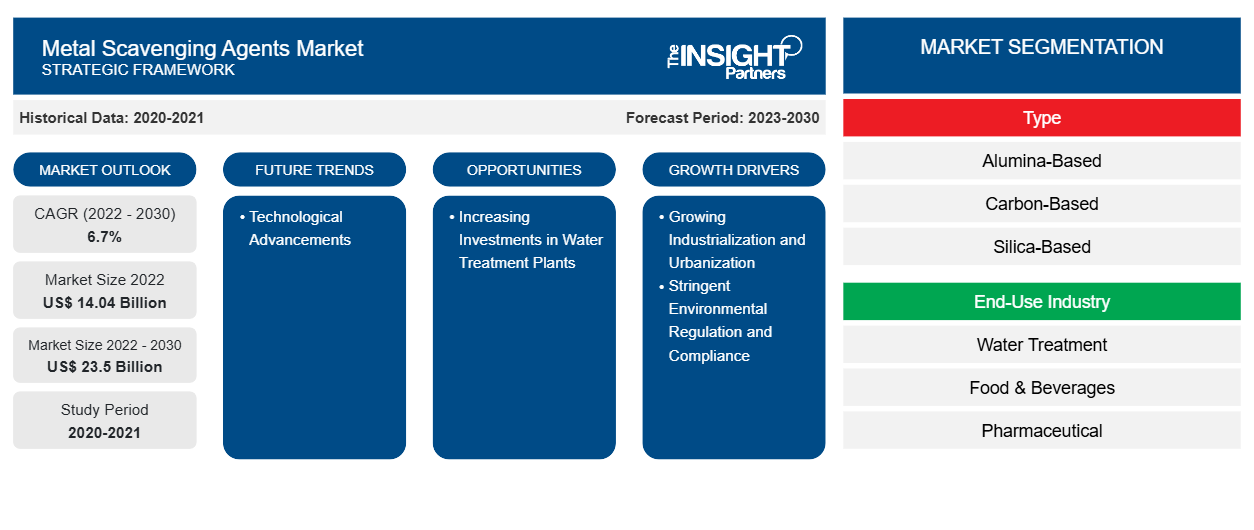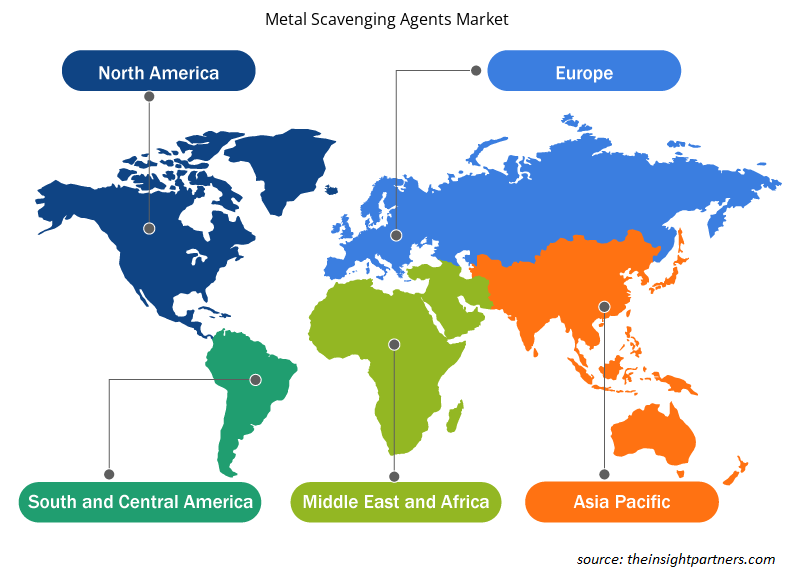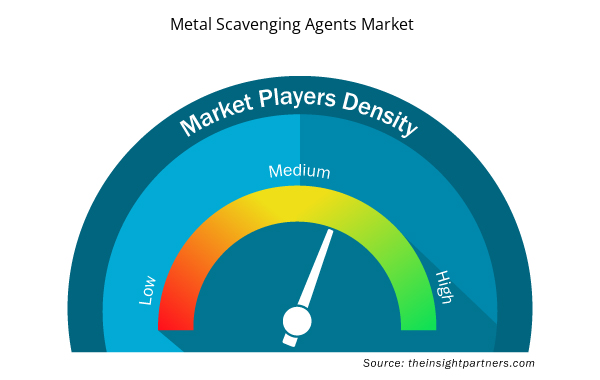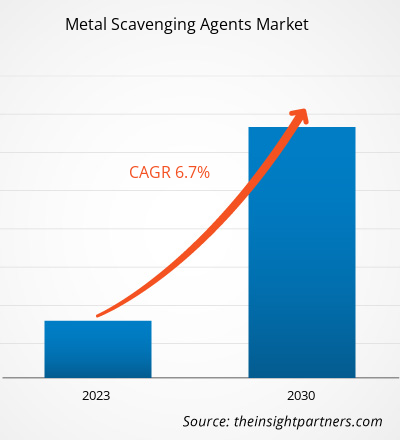[Research Report] The metal scavenging agents market was valued at US$ 14,040.95 million in 2022 and is expected to reach US$ 23,502.69 million by 2030; it is estimated to register a CAGR of 6.7% from 2022 to 2030.
MARKET ANALYSIS
Metal scavenging agents are substances designed to selectively bind and remove metal ions from solutions or matrices. They are used in various industrial processes such as wastewater treatment, metal recovery, and chemical purification. The agents typically contain functional groups that have a high affinity for specific metal ions, allowing them to form complexes and facilitate their removal through precipitation, adsorption, or other separation methods. Examples of metal scavenging agents are chelating agents such as EDTA (ethylenediaminetetraacetic acid), DTPA (diethylenetriaminepentaacetic acid), and NTA (nitrilotriacetic acid); ion exchange resins; activated carbon; and various polymers. The global metal scavenging agents market size is likely to upsurge by 2030 owing to the increasing investments in water treatment plants.
The growing utilization of metal scavenging agents in the pharmaceutical industry contributes significantly to the metal scavenging agents market growth. In the industry, the agents play a crucial role in ensuring the efficacy, safety, and stability of pharmaceutical products. Copper, zinc, iron, and other metal ions can accelerate oxidation, hydrolysis, and other chemical reactions in drug formulations, leading to decreased potency, changes in physical appearance, and the formation of toxic byproducts. The primary application of metal scavenging agents in the industry is in the formulation of parenteral drugs such as injectables and intravenous solutions. These formulations are susceptible to metal-catalyzed oxidation, which can lead to degradation of active pharmaceutical ingredients (APIs) and lead to the formation of potentially harmful impurities. Metal scavengers are added to parenteral formulations to chelate metal ions present in water, excipients, and packaging materials, thereby preventing oxidative degradation and ensuring the stability of the drug product throughout its shelf life.
GROWTH DRIVERS AND CHALLENGES
The growing industrialization and urbanization and stringent environmental regulation and compliance contribute to the growing metal scavenging agents market size. As of July 2023, annual construction spending in the manufacturing sector totaled US$ 201 billion, an increase of 70% from the previous year, setting the stage for further growth in 2024. As industrial activities expand across the world, there is a parallel increase in metal contamination across various environmental media such as water bodies, soil, and air. The contamination arises from diverse sources, including industrial processes, urban runoff, and improper waste disposal practices. Industries such as mining, manufacturing, and chemical processing generate effluents and emissions laden with heavy metals such as lead, mercury, cadmium, and chromium. These metals pose serious environmental pollution and cause health risks, as they can persist in the environment, accumulate in ecosystems, and bioaccumulate in organisms, ultimately entering the food chain and posing risks to human health and wildlife. The governments and regulatory bodies worldwide have imposed stringent environmental regulations in response to the urgent need to address the detrimental environmental and health impacts stemming from heavy metal pollution. Governments establish stringent limits on the permissible concentration of heavy metals in industrial effluents and emissions, aiming to safeguard water quality, soil integrity, and air purity. In adhering to these regulations, industries are compelled to deploy effective solutions such as metal scavenging agents to ensure their discharge levels meet the mandated limits. The pressure for regulatory compliance is immense, as noncompliance can result in severe fines, penalties, and legal repercussions. However, the substantial initial investment required for implementing metal scavenging solutions presents a significant hurdle for small and medium-sized enterprises (SMEs), particularly in emerging economies with limited capital resources. SMEs operating in these regions often face financial constraints and competing priorities, making it challenging to allocate funds for costly equipment, infrastructure, and specialized materials associated with metal scavenging technologies. As a result, SMEs may prioritize immediate operational needs over long-term environmental investments, viewing pollution control measures as nonessential or low priority.
Customize This Report To Suit Your Requirement
You will get customization on any report - free of charge - including parts of this report, or country-level analysis, Excel Data pack, as well as avail great offers and discounts for start-ups & universities
Metal Scavenging Agents Market: Strategic Insights

- Get Top Key Market Trends of this report.This FREE sample will include data analysis, ranging from market trends to estimates and forecasts.
You will get customization on any report - free of charge - including parts of this report, or country-level analysis, Excel Data pack, as well as avail great offers and discounts for start-ups & universities
Metal Scavenging Agents Market: Strategic Insights

- Get Top Key Market Trends of this report.This FREE sample will include data analysis, ranging from market trends to estimates and forecasts.
REPORT SEGMENTATION AND SCOPE
The "Global Metal Scavenging Agents Market Analysis and Forecast to 2030" is a specialized and in-depth study focusing significantly on global market trends and growth opportunities. The report aims to provide an overview of the global market with detailed market segmentation on the basis of type, end-use industry, and region. The report provides key statistics on the use of metal scavenging agents across the region, along with their demand in major countries. In addition, it provides a qualitative assessment of various factors affecting the metal scavenging agents market growth in major countries. It also includes a comprehensive analysis of the leading players in the market and their key strategic developments. Analysis of the market dynamics is also included to help identify the key driving factors, market trends, and lucrative opportunities that would, in turn, aid in identifying the major revenue pockets. Additionally, the metal scavenging agents market trends include technological advancements. Ongoing research and development efforts in the field of metal scavenging technologies are driving the emergence of advanced solutions poised to revolutionize metal removal processes. Innovations such as nanomaterial-based adsorbents, functionalized membranes, and hybrid sorbent systems can represent promising avenues for achieving higher efficiency, selectivity, and sustainability in metal scavenging applications.
The ecosystem analysis and Porter’s five forces analysis provide a 360-degree view of the global metal scavenging agents market, which helps understand the entire supply chain and various factors influencing the market growth.
SEGMENTAL ANALYSIS
The global metal scavenging agents market is segmented on the basis of type and end-use industry. Based on type, the market is segmented into alumina-based, carbon-based, silica-based, resin-based, and others. The alumina-based segment accounts for the significant metal scavenging agents market share. Alumina-based metal scavenging agents are crucial components in various industrial processes, particularly in industries such as pharmaceuticals, water treatment, and environmental remediation. Alumina, typically in the form of aluminum oxide (Al2O3), possesses a high surface area and a strong affinity for metal ions due to its amphoteric nature. The agents are adept at chelating or binding metal ions through surface complexation, ion exchange, and chemisorption mechanisms. In water treatment, alumina-based metal scavenging agents are utilized to remove heavy metals such as arsenic, lead, and chromium from contaminated water sources, thus safeguarding public health. Moreover, in pharmaceutical manufacturing, alumina-based metal scavengers play a vital role in purifying drug formulations by eliminating trace metal impurities that could compromise product quality or pose health risks to consumers. Additionally, in environmental remediation efforts, alumina-based metal scavenging agents are employed to mitigate metal pollution in soil and groundwater, aiding in the restoration of ecosystems affected by industrial activities or accidental spills.
Based on end-use industry, the global metal scavenging agents market is segmented into water treatment, food & beverage, pharmaceutical, oil & gas, chemicals, paper & pulp, and others. The oil & gas segment accounts for the significant metal scavenging agents market share. In oil refining processes, metal scavenging agents are used to neutralize metal contaminants that can catalyze undesired reactions such as hydroprocessing catalyst poisoning, coke formation, and sulfur compound degradation. Iron and nickel, for example, can deactivate catalysts used in hydrotreating and hydrocracking units, leading to reduced process efficiency and increased operating costs. By chelating metal ions, scavenging agents prevent catalyst deactivation; extend catalyst life; and improve the yield and quality of refined products such as gasoline, diesel, and jet fuel.
REGIONAL ANALYSIS
The report provides a detailed overview of the global metal scavenging agents market with respect to major regions, including North America, Europe, Asia Pacific (APAC), the Middle East & Africa (MEA), and South & Central America (SAM). Asia Pacific accounted for the largest market share and was valued at ∼US$ 5 billion in 2022. The region comprises a significant number of water treatment plants and is a hub for paper and pulp businesses operating in the region. Asia Pacific has been noticed as one of the prominent markets for the utilization of metal scavenging agents owing to the growing chemical and oil & gas sectors and rising urbanization leading to increasing demand for water treatment. Moreover, government initiatives and policies such as Make-in-India encourage the setup of different manufacturing plants in India. The market in Europe is expected to reach ∼US$ 6 billion by 2030. The metal scavenging agents market in North America is expected to record a CAGR of ~6% from 2022 to 2030.
Metal Scavenging Agents Market Regional Insights
The regional trends and factors influencing the Metal Scavenging Agents Market throughout the forecast period have been thoroughly explained by the analysts at Insight Partners. This section also discusses Metal Scavenging Agents Market segments and geography across North America, Europe, Asia Pacific, Middle East and Africa, and South and Central America.

- Get the Regional Specific Data for Metal Scavenging Agents Market
Metal Scavenging Agents Market Report Scope
| Report Attribute | Details |
|---|---|
| Market size in 2022 | US$ 14.04 Billion |
| Market Size by 2030 | US$ 23.5 Billion |
| Global CAGR (2022 - 2030) | 6.7% |
| Historical Data | 2020-2021 |
| Forecast period | 2023-2030 |
| Segments Covered |
By Type
|
| Regions and Countries Covered | North America
|
| Market leaders and key company profiles |
Metal Scavenging Agents Market Players Density: Understanding Its Impact on Business Dynamics
The Metal Scavenging Agents Market is growing rapidly, driven by increasing end-user demand due to factors such as evolving consumer preferences, technological advancements, and greater awareness of the product's benefits. As demand rises, businesses are expanding their offerings, innovating to meet consumer needs, and capitalizing on emerging trends, which further fuels market growth.
Market players density refers to the distribution of firms or companies operating within a particular market or industry. It indicates how many competitors (market players) are present in a given market space relative to its size or total market value.
Major Companies operating in the Metal Scavenging Agents Market are:
- Biotage
- Johnson Matthey
- SupraSciences
- SiliCycle Inc.
- Sigma-Aldrich
Disclaimer: The companies listed above are not ranked in any particular order.

- Get the Metal Scavenging Agents Market top key players overview
COMPETITIVE LANDSCAPE AND KEY COMPANIES
Biotage, Johnson Matthey, SupraSciences, SiliCycle Inc., Sigma-Aldrich, Fuji Silysia, PhosphonicS, Vizag Chemicals, Biosynth, and BASF SE are among the prominent players profiled in the metal scavenging agents market report. In addition, several other players have been studied and analyzed during the study to get a holistic view of the market and its ecosystem. The metal scavenging agents market report also includes company positioning and concentration to evaluate the performance of competitors/players in the market.
INDUSTRY DEVELOPMENTS AND FUTURE OPPORTUNITIES
According to the press releases, a few initiatives taken by the key players operating in the metal scavenging agents market are listed below:
- In December 2023, ITM Isotope Technologies Munich signed a licensing agreement with Merck KGaA for the clinical development and commercialization of radiolabeled folate derivatives for therapeutic and diagnostic applications against folate-receptor-positive malignant tumors.
- In January 2022, Johnson Matthey partnered with European Metal Recycling (EMR) to develop an efficient value chain in the UK to recycle lithium-ion batteries and cell manufacturing materials.
- Historical Analysis (2 Years), Base Year, Forecast (7 Years) with CAGR
- PEST and SWOT Analysis
- Market Size Value / Volume - Global, Regional, Country
- Industry and Competitive Landscape
- Excel Dataset



Report Coverage
Revenue forecast, Company Analysis, Industry landscape, Growth factors, and Trends

Segment Covered
Type, and End-Use Industry

Regional Scope
North America, Europe, Asia Pacific, Middle East & Africa, South & Central America

Country Scope
This text is related
to country scope.
Frequently Asked Questions
Can you list some of the major players operating in the global metal scavenging agents market?
The major players operating in the global metal scavenging agents market are Biotage, Johnson Matthey, SupraSciences, SiliCycle Inc., Sigma-Aldrich, Fujisilysia, Phosphonics, Vizagchemicals, Biosynth, and BASF SE.
What are the opportunities for metal scavenging agents in the global market?
There are growing investments in water treatment infrastructure, especially in developing economies grappling with water scarcity and pollution issues. These investments are driven by the urgent need to address the challenges of inadequate access to clean and safe drinking water and the escalating concerns over water pollution caused by industrial, agricultural, and urban activities.
Based on type, why did the silica-based segment account for a significant market share in 2022?
Based on type, the market is segmented into alumina-based, carbon-based, silica-based, resin-based, and others. The silica-based segment accounts for a significant metal scavenging agents market share. Silica-based metal scavenging agents are composed of porous silica particles functionalized with specific ligands or chelating groups capable of binding to metal ions.
Which is the largest geographic region within the global metal scavenging agents market?
Asia Pacific has been noticed as one of the prominent markets for the utilization of metal scavenging agents owing to the growing chemical and oil & gas sectors and rising urbanization leading to increasing demand for water treatment. Moreover, government initiatives and policies such as Make-in-India encourage the setup of different manufacturing plants in India.
What are the key drivers for the growth of the global metal scavenging agents market?
As industrial activities expand across the world, there is a parallel increase in metal contamination across various environmental media such as water bodies, soil, and air. The contamination arises from diverse sources, including industrial processes, urban runoff, and improper waste disposal practices.
Based on the end-use industry, which segment is projected to grow significantly during the forecast period?
Based on end use industry, the global metal scavenging agents market is segmented into water treatment, food & beverage, pharmaceutical, oil & gas, chemicals, paper & pulp, and others. Metal scavenging agents play a crucial role in the water treatment industry, where the removal of heavy metals from water sources is paramount for environmental protection and human health.
Trends and growth analysis reports related to Chemicals and Materials : READ MORE..
The List of Companies - Metal Scavenging Agents Market
- Biotage
- Johnson Matthey
- SupraSciences
- SiliCycle Inc.
- Sigma-Aldrich
- Fuji Silysia
- PhosphonicS
- Vizag Chemicals
- Biosynth
- BASF SE

 Get Free Sample For
Get Free Sample For